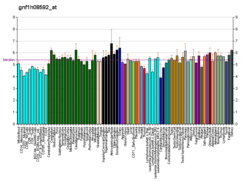SLC32A1
Vesicular inhibitory amino acid transporter is a protein that in humans is encoded by the SLC32A1 gene.[5]
The protein encoded by this gene is an integral membrane protein involved in gamma-aminobutyric acid (GABA) and glycine uptake into synaptic vesicles. The encoded protein is a member of amino acid/polyamine transporter family II.[5]
See also
References
Further reading
- McIntire SL, Reimer RJ, Schuske K, et al. (1997). "Identification and characterization of the vesicular GABA transporter". Nature. 389 (6653): 870–6. doi:10.1038/39908. PMID 9349821.
- Kleiderlein JJ, Nisson PE, Jessee J, et al. (1999). "CCG repeats in cDNAs from human brain". Hum. Genet. 103 (6): 666–73. doi:10.1007/s004390050889. PMID 9921901.
- Deloukas P, Matthews LH, Ashurst J, et al. (2002). "The DNA sequence and comparative analysis of human chromosome 20". Nature. 414 (6866): 865–71. doi:10.1038/414865a. PMID 11780052.
- Chessler SD, Simonson WT, Sweet IR, Hammerle LP (2002). "Expression of the vesicular inhibitory amino acid transporter in pancreatic islet cells: distribution of the transporter within rat islets". Diabetes. 51 (6): 1763–71. doi:10.2337/diabetes.51.6.1763. PMID 12031963.
- Jellali A, Stussi-Garaud C, Gasnier B, et al. (2002). "Cellular localization of the vesicular inhibitory amino acid transporter in the mouse and human retina". J. Comp. Neurol. 449 (1): 76–87. doi:10.1002/cne.10272. PMID 12115694.
- Strausberg RL, Feingold EA, Grouse LH, et al. (2003). "Generation and initial analysis of more than 15,000 full-length human and mouse cDNA sequences". Proc. Natl. Acad. Sci. U.S.A. 99 (26): 16899–903. doi:10.1073/pnas.242603899. PMC 139241. PMID 12477932.
- Geigerseder C, Doepner R, Thalhammer A, et al. (2003). "Evidence for a GABAergic system in rodent and human testis: local GABA production and GABA receptors". Neuroendocrinology. 77 (5): 314–23. doi:10.1159/000070897. PMID 12806177.
- Ota T, Suzuki Y, Nishikawa T, et al. (2004). "Complete sequencing and characterization of 21,243 full-length human cDNAs". Nat. Genet. 36 (1): 40–5. doi:10.1038/ng1285. PMID 14702039.
- Gerhard DS, Wagner L, Feingold EA, et al. (2004). "The status, quality, and expansion of the NIH full-length cDNA project: the Mammalian Gene Collection (MGC)". Genome Res. 14 (10B): 2121–7. doi:10.1101/gr.2596504. PMC 528928. PMID 15489334.
This article is issued from
Wikipedia.
The text is licensed under Creative Commons - Attribution - Sharealike.
Additional terms may apply for the media files.




